financing SFM
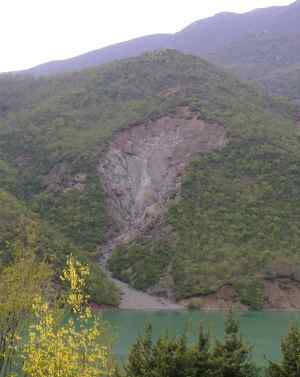
Share
External Related Links
Attachments
INNOVATIVE%20FINANCING%20FOR%20SUSTAINABLE%20FOREST%20MANAGEMENT_0.pdf
Authors/Partners
World Bank, SNV Netherlands Development Organization, Natural Resources Solutions consultancy - Kosovo, REGEA Croatia, Diava Consulting - Albania, Faculty of Forestry - Macedonia, Wageningen University - The Netherlands
Innovative Financing for Sustainable Forest Management in the Southwest Balkans
CHALLENGE
In many countries—particularly in the Balkans—most of the environmental services provided by the sustainable management of forests and uplands are seldom quantified, often not valued, and even more rarely captured by the owners/managers of these resources. Capturing these benefits has the potential to enhance the environmental management of forest resources, protect landscapes from erosion and downstream water systems from siltation and flooding, increase carbon sequestration (with a possible decrease in consumption of fossil fuels), while at the same time helping to address rural poverty.
To increase the likelihood of payment for these environmental services, the value and scale of the benefits generated need to better understood.
APPROACH
With support from multiple partners including PROFOR, the World Bank’s Europe and Central Asia staff is undertaking two case studies to assess:
- the benefits of sustainable upland forest and land management for downstream water users, and
- the effectiveness of increasing the use and efficiency of firewood in reducing the use of fossil fuels and hence greenhouse gas emissions.
The first case study focuses primarily on the Ulza hydro-power dam and watershed in Albania. The second case study looks mainly at wood supply, stoves, and heating systems in Kosovo.
This research aims to define scientifically sound methodologies; establish key baseline data in some case studies; provide quantitative estimates of the value of specific targeted environmental services; propose mechanisms to start or increase payment for these services in the two countries; and then disseminate the results and experience both regionally and more broadly. The results will be particularly helpful for countries in the process of European Union accession, as they develop agro-environmental payments within the common agriculture policy.
RESULTS
All field work and data collection activities for the two case studies have concluded. Thirty-two project publications have been translated into Albanian and disseminated through the project website http://www.cnvp-wbprofor.org/home.html, the project blog http://wbprofor.blog.com, and the project Facebook page. The main publication Study and Analysis of Innovative Financing for Sustainable Forest Management in the Southwest Balkan: Innovative Financing for Sustainable Forest Management (September 2013) is also available on PROFOR website. A series of stakeholder workshops was held in Albania and Kosovo. The final results workshop for Albania took place in September 2013 in Tirana, and the final results workshop for Kosovo occurred on in Prishtina the same month.
FINDINGS
The project generated numerous findings that are detailed in the project publications. Highlights include the following:
Albania
-At least 31.5% of the Ulza reservoir storage is filled with sediment.
-Erosion and sediment are correlated to land uses in a measurable way, with forested areas producing the lowest sediment load.
-Around 12% of stakeholders in the watershed are willing to pay for environmental services such as reduced erosion and reduced sedimentation.
Kosovo
-Total wood biomass production is about 1.25 million cubic meters, of which 0.17 million cubic meters is legally harvested forest.
-95% of wood harvested from forests is used for firewood.
-Improving existing agroforestry sites and introducing fast-growing species are good opportunities to increase wood biomass production.
-Wood biomass is an economically attractive energy option for individual household heating and public buildings.
-Carbon markets could support energy production from wood biomass.
This activity is ongoing. A website dedicated to sharing the results of this activity has been set up at the following address: http://www.cnvp-wbprofor.org/home.html.Key findings and reports will also be shared on this page. You can also follow us on twitter (www.twitter.com/forestideas) or subscribe to our mailing list for regular updates.
For stories and updates on related activities, follow us on twitter and facebook , or subscribe to our mailing list for regular updates.
Author : World Bank, SNV Netherlands Development Organization, Natural Resources Solutions consultancy - Kosovo, REGEA Croatia, Diava Consulting - Albania, Faculty of Forestry - Macedonia, Wageningen University - The Netherlands
Last Updated : 06-16-2024

Share
Related Links
Adjusted Net National Income data by country
How to calculate Adjusted Net Saving
The Changing Wealth of Nations (World Bank)
Wealth Accounting and the Valuation of Ecosystem Services (WAVES website)
More environment data from the World Bank
Attachments
AGS Final Report on Improved Domestic Timber FINAL(2)_1.pdf
Authors/Partners
PROFOR, WAVES, RFF
Improving the Forests Database to Support Sustainable Forest Management
CHALLENGE
At the heart of whether growth in a country is green and sustainable is the issue of accumulation of wealth. It is wealth — broadly defined to include manufactured capital, natural capital (including forests), human and social capital— that underlies the generation of national income. Gross domestic product (GDP) has conventionally been used to assess economic performance, measuring economic growth from one year to the next. But GDP does not take into account depreciation and depletion of wealth, and therefore does not provide an indication of whether growth is sustainable: an economy could appear to be growing in the near term by running down its assets such as its forests. Assessments of economic performance should therefore be based on both measures of annual growth (such as GDP) and measures of the comprehensive wealth of a country, which indicate whether that growth is sustainable in the long term.
For the past 15 years, the World Bank has provided indicators to measure the sustainability of a country’s growth path, such as Adjusted Net Saving (ANS), adjusted Net National Income (aNNI), and comprehensive wealth estimates. Underpinning these indicators are data on natural resource rents (from forests, minerals, and energy) which provide policy makers with information on potential revenues from natural capital.
The comprehensive wealth accounts, which have been published for 1995, 2000, and 2005, include estimates for forest wealth which is calculated as the sum of the net present value of rents from timber extraction and annual benefits from non-timber resources, including minor forest products, hunting, recreation, and watershed protection. ANS, which is published annually and covers the period 1970-present, is defined as net national saving adjusted for investments in human capital, depletion of natural resources (including forests), and damages to human health caused by pollution, and provides an estimate of the annual change in wealth.
Recent findings suggest that while wealth data and ANS data are used by researchers and policy analysts, the greatest demand is for data on natural resource rents. However, while minerals and energy rent data have gained a lot of traction, rent data for forests are not used as frequently. Interviews have revealed concerns with the credibility of the underlying data, such as the FAO data on forest area and growing stock. The authors of the indicators have also concluded that a number of methodological changes could improve estimates for forest wealth, potential forest rents, and net forest depletion.
APPROACH
This activity hopes to increase the use of improved World Bank forest data (forest rents, net forest depletion, and forest wealth), so that countries and data users are better equipped with credible and more accurate information on the physical area and value of forest resources. Countries should consider not just the flow of revenues from forest resources, but also the sustainable management of the asset (stock of forest resources).
- Data on the value of forest wealth, its share in total wealth, and how the value is changing over time can help governments assess the contribution of forests to current development outcomes and whether forests are being managed sustainably.
- Data on potential forest rents when combined with information on actual rent recovery and use of these revenues will allow governments to assess whether contribution of forest resources to sustainable development is being realized and who is benefitting from the revenue. Such data and assessments can equip policymakers to better manage forest resources, improve forest governance, increase transparency in the rent captured, and ultimately lead to increased reinvestment of forest rents in other forms of capital to grow the total wealth of the country.
- These policy changes could, in turn, promote the sustainable management of forest resources for poverty reduction and economic growth.
RESULTS
The activity has been successfully completed.
A report is being finalized and will be released soon. The report reviews the latest literature, explores improved data sources, evaluates key parameters and assumptions in the methodology, and outlines the steps and resources required to improve the data and methods.
An implementation plan for updating the forest database that includes a plan for country surveys if the report finds insufficient global data will be finalized in the coming months.
For stories and updates on related activities, follow us on Twitter and Facebook, or subscribe to our mailing list for regular updates
For stories and updates on related activities, follow us on twitter and facebook , or subscribe to our mailing list for regular updates.
Author : PROFOR, WAVES, RFF
Last Updated : 06-16-2024
Fostering Partnerships Between Local Communities and the Private Sector in Kenya
Support to Forest Sector Reform in Kenya, 2004-2005
CHALLENGE
A combination of corruption and illegal excisions in the latter half of the 1990s reduced the area of industrial plantations in Kenya government forest reserves from 160,000 hectares to about 120,000 hectares. These forest excisions have created major environmental, economic and social problems. Illegal logging in indigenous forests has mushroomed and is negatively impacting on the biodiversity and the vital water catchment protection functions of Kenya's remaining upland forests.
Further, uncertainties about the possibility to sustain the industrial round wood (IRW) requirements for Kenya's sawmilling, wood based panel and pulp and paper industries led to a government decision in the late 1990s to ban logging and to close down most sawmilling enterprises. As a result, many displaced forest workers are living in shanty townships, wood costs have soared, and the future survival of Kenya's pulp, paper and wood-based panel industries is under serious threat.
APPROACH
A new forest bill and revised forest policy aimed to buck this trend and shift the emphasis of forest management to local communities and the private sector. In this context, PROFOR worked in partnership with the IFC and other donors to improve opportunities for collaboration between the private sector, local communities and smallholders.
RESULTS
PROFOR helped to move the national dialogue forward by providing information on a range of partnership schemes and guidelines for engaging companies, communities, and stakeholders. A Forest Investment Workshop hosted by the World Bank and PROFOR in Nairobi in November 2004 identified several possible business-community or business-smallholder partnership-based approaches that could be suitable for pilot scale testing.
The following year, PROFOR continued to support the development of forest sector partnership in Kenya, by providing insights on three topics: 1) Kenya Forestry: Economics and Financial Viability; 2) Forestry Partnerships in Kenya A Review of Issues for business- farmer, and government community - business arrangements for wood production; and 3) Kenya Interim Industrial Wood Supply Strategy. The reports are available on this page.
Besides contributing to a reform process which eventually culminated in the creation of a forest service in Kenya, PROFOR's work in Kenya informed a larger Eastern and Southern Africa Region Forest Investment Forum in South Africa in 2006.
For stories and updates on related activities, follow us on twitter and facebook , or subscribe to our mailing list for regular updates.
Last Updated : 06-15-2024
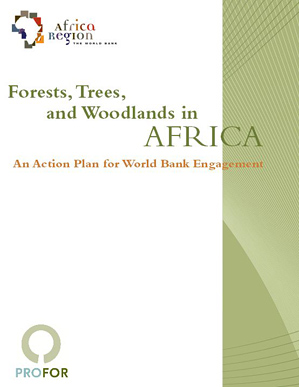
Share
Related Links
Attachments
Africa-Forests-Trees-ActionPlan_0_0.pdf
Authors/Partners
World Bank Africa Region
Forests in Sub-Saharan Africa: Challenges & Opportunities
CHALLENGE
More than 70 percent of the population in Sub-Saharan Africa depends on forests and woodlands for its livelihood; one fifth of rural families’ daily needs come from forests. Woodlands and forests supply approximately 60 percent of all energy. Forest-related activities accounts for a large part of the GDP of most of the continent’s countries. And, Africa is home to 25 percent of the world’s remaining rainforests.
Despite significant international financial support to the forestry sector in the Sub-Saharan African countries, impacts on sustainable management and poverty alleviation are still below expectations.
APPROACH
PROFOR support to the World Bank’s Africa region sought to meet the need for a more comprehensive approach to tackling forest-related challenges and proposing solutions. This approach could help countries better incorporate forestry issues into overall development policy, identify priority actions, and help donors/partners who support development and forestry in Africa coordinate and finance programs more strategically.
PROFOR funding supported:
- A review of forestry documentation on Sub-Saharan Africa.
- Identification of challenges and issues in sub-regions, with an emphasis on obtaining lessons from past successes or failures.
- Identification of recommended options with an Action Plan; roles and responsibilities; partners and if possible indications of required financing.
- Coordination among development partners (multilateral and bilateral).
RESULTS
Findings from this activity were incorporated in Forest, trees, and woodlands in Africa : an action plan for World Bank engagement (June 2012). The report lays out 7 action areas, which involve policy measures, increased investments and a greater push for sound governance to better manage forests:
- Sustainable protection and development for wood-fuel and charcoal industries to serve domestic (and potentially export) markets;
- Landscape and watershed restoration, including planting trees and the development of policy measures to prevent future and mitigate past damages from mining investments;
- Plantation management to support a range of timber products in addition to wood-fuel including poles for construction and electricity transmission lines and furniture;
- Reforms and incentives in the domestic timber industry to reduce waste and support legal timber operators;
- Increased management planning, development, and financing for protected areas, community-based resource management and eco-tourism;
- Improved forest sales management in heavily forested countries
- Development of REDD+ (reduced emissions from deforestation and forest degradation) programs and carbon finance to help countries capture potential revenues from the carbon storing value of forests and promote co-benefits with communities through landscape restoration and reforestation projects.
Because of the geographic and climatic diversity in Africa, these action areas are adapted for the specific environmental challenges in each sub-region region (Sahel, humid West Africa, Central Africa, Eastern Africa, Southern Africa).
The report stresses that there is an urgent need to improve the availability and quality of information, especially statistical data, surrounding forests and woodlands. Mobile phones and other Information Communications and Technology are already being used to improve the collection and dissemination of forest data, including real-time fire alerts, game density mapping, and verification for legal timber operations.
For stories and updates on related activities, follow us on twitter and facebook , or subscribe to our mailing list for regular updates.
Author : World Bank Africa Region
Last Updated : 06-15-2024
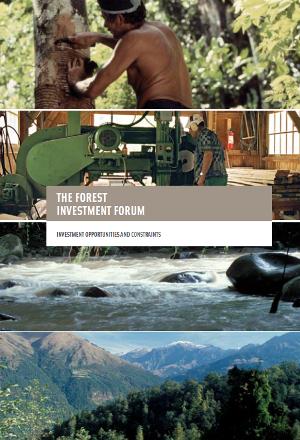
Share
Related Links
Attachments
Authors/Partners
World Bank, the International Finance Corporation (IFC), World Business Council for Sustainable Development (WBCSD), WWF, the Program on Forests (PROFOR), and Forest Trends
Forest Investment Forum
CHALLENGE
Private foreign direct investment (FDI) in the forest sector considerably exceeds public official development assistance (ODA). In recent years, forest financing has been characterized by an increase in FDI into developing countries to approximately US$8-10 billion a year, and a decline in ODA to about US$1.75 billion a year. However, current levels of investment in the forest sector, both domestic and foreign, fall far short of investment requirements necessary to realize the potential of well-managed forest resources to contribute to poverty alleviation, the protection of vital environmental services, and sustainable economic growth in developing and transition countries.
APPROACH
To address this issue, a Forest Investment Forum was convened in October 2003 at World Bank Headquarters in Washington DC. The forum brought together 150 senior executives of domestic and multinational forest product companies, private and public sector financial institutions, and leading conservation agencies from around the world. Organized jointly by the World Bank, the International Finance Corporation (IFC), World Business Council for Sustainable Development (WBCSD), WWF, the Program on Forests (PROFOR), and Forest Trends, the forum set out to:
- Identify opportunities for investments in environmentally and socially sustainable forestry in developing and economic transition countries;
- Consider actions that the World Bank Group and Forum participants could take to create an enabling environment for responsible private sector investment; and
- Explore the willingness of forum participants to support a process to develop clearly defined and mutually compatible social, economic and environmental investment guidelines specific to the forest sector.
The Forest Investment Forum report includes the forum organizers' outcome statement, a summary of discussions, and an analysis of opportunities and key constraints to environmentally and socially responsible private sector investment in the forest sector.
MAIN FINDINGS
The Forum provided an opportunity for lively discussion that served to successfully hone in on key constraints needing further address, specifically:
- Insecurity of raw material supply and political instability. These represent risks for investors and threaten the continuity of manufacturing operations. Special emphasis was given to the need for the reform of timber concessions, with the aims specifically of: introducing greater transparency into timber allocation processes; involving local communities in the dialogue; achieving equitable revenue sharing; encouraging value-added processing; and guaranteeing to responsible timber companies the long-term security of raw material supply.
- Illegal logging and forest-related corruption. Illegal activities in many countries are a deterrent to responsible private sector investment. Numerous initiatives have been launched to address these issues, and some governments have displayed a willingness to put the issues of forest-related corruption and improved forest governance high on their agendas.
- Lack of environmental assessment procedures and safeguard policies. This can both deter socially and environmentally responsible companies and encourage investment by irresponsible operators. Weak institutional mechanisms for the monitoring of environmental procedures and safeguard policies furthermore can impede the implementation of such procedures and policies.
- Lack of consensus on independent certification. There is much confusion in the marketplace over the merits of the different certification schemes. Attempts to achieve mutual recognition so far have been unsuccessful, and the emphasis has shifted to development of minimum standards or legitimacy thresholds, and to the definition of processes for measuring step-by-step progress toward SFM.
- Inconsistent strategies for the protection of high-conservation-value forests (HCVFs). The different strategies employed by industry and conservation groups to protect HCVFs and to integrate biodiversity protection into forest management practices must be brought into accord.
- Debate on the impacts of plantation-based forestry. Given the worldwide trend toward greater reliance on plantation forests, there is a need for agreement between the conservation community and industry on where and how plantation forests can be developed such that any potentially negative social and environmental impacts can be avoided. Small-scale farm and community-owned plantations can play a key role in contributing to income generation and to economic growth.
- Markets for forest environmental services are underdeveloped. An enabling environment must be developed to help accelerate private sector investment in environmental services such as carbon sequestration, biodiversity protection, and water services must be encouraged through developing an enabling environment for such investment. Encouraging progress has been made in recent years, and some 280 deals have been concluded. However, uncertainties about these markets and their potential financial benefits remain a constraint to the replication of such deals.
- The financial mechanisms and technical assistance support for small and medium-size forest enterprises are inadequate. The forum discussed opportunities for partnerships between larger forest industrial companies and small-scale, low-income producers. A number of partnerships are making a significant contribution to community livelihoods and to resolving problems such as the clarification of land rights. However, community bargaining power and the ability to mobilize capital remain weak.
For stories and updates on related activities, follow us on twitter and facebook , or subscribe to our mailing list for regular updates.
Author : World Bank, the International Finance Corporation (IFC), World Business Council for Sustainable Development (WBCSD), WWF, the Program on Forests (PROFOR), and Forest Trends
Last Updated : 06-15-2024
Share
Authors/Partners
Community Enterprise Forum International (CEFI)
Forest Enterprise Information Exchange (FEINEX)
CHALLENGE
Access to markets is fundamental to the goal of improving livelihood security for a growing number of micro entrepreneurs in the forest produce domain. But this access depends on efficient service delivery which in turn relies on useful and complete information provision to micro entrepreneurs.
APPROACH
As part of the Forest Connect alliance, the Forest Enterprise Information Exchange (FEINEX) initiative is evaluating the processes and systems that enhance efficiency in the agricultural SME sector. It will then incorporate and adapt lessons to enable increased profits – economic and ecological -- for the forest enterprise sector.
The project will generate three databases 1) a portfolio of services offered by the agriculture service extension system of the central and state governments, 2) a plant disease outbreak and management information database, and 3) a stakeholder database of current service providers and intermediaries.
In addition to creating its own communications and sharing platform, FEINEX is sharing lessons learnt through the Forest Connect alliance.
RESULTS
With PROFOR support, an Indian non-profit organization called Community Enterprise Forum International (CEFI) produced in 2010 a database of 7,000 small and medium scale forest enterprises (SMFEs) and service providers that is helping link enterprises to markets, service providers and policy processes in the Indian states of Orissa, Maharshtra, Tamil Ndu, Uttarakhand, Kerala and Chhattisgarh.
The size of the database largely exceeded initial estimates as interest from SMFEs escalated. The database includes more than 1,000 non-timber forest product gatherers, classified and categorized by the species they usually collect.
For stories and updates on related activities, follow us on twitter and facebook , or subscribe to our mailing list for regular updates.
Author : Community Enterprise Forum International (CEFI)
Last Updated : 06-15-2024
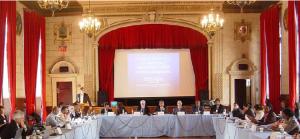
Exploring the Potential for Avoided Deforestation
Reducing Emissions from Deforestation in Developing Countries -- A Policy Workshop for UNFCCC COP11 Agenda Item #6
CHALLENGE
Continued tropical deforestation is thought to be the second leading cause of global greenhouse gas emissions, behind fossil fuel combustion. The UNFCCC Parties at COP-11 referred the issue of tropical deforestation to the Subsidiary Body for Scientific and Technical Advice (SBSTA) as part of a two-year process. This process was part of a broad dialogue on procedural, technical and policy issues pertaining to tropical deforestation in developing countries that resulted in recommendations to the UNFCCC's COP-13 in Bali in December 2007.
APPROACH
In partnership with the Rainforest Coalition, PROFOR and the World Bank sponsored a two-day workshop at Columbia University from March 13-14, 2006, on reducing emissions from deforestation in developing countries. The event's purpose was to facilitate the development of a quality portfolio for the 'Submission of Views' to the UNFCCC Secretariat (due March 31st 2006) and to develop a strategy that would lead to meaningful solutions for deforestation in developing countries.
For stories and updates on related activities, follow us on twitter and facebook , or subscribe to our mailing list for regular updates.
Author : Rainforest Coalition
Last Updated : 06-15-2024
Evaluating the Flows of Financing for Sustainable Forest Management
An Input Paper to the UNFF (2003)
UNFF stands for the United Nations Forum on Forest. The Forum's support for sustainable forest management is guided by a Multi-Year Program of Work comprised of sixteen elements based on the proposals for action of the Intergovernmental Panel on Forests (IPF) and the Intergovernmental Forum on Forests (IFF).
At the third session of the UNFF (UNFF3), "Economic aspects of forests" was one of the major elements for discussion. To inform this discussion, the World Bank prepared an input paper providing a review of policy reforms, projects and programs at the national and international levels related to the economic aspects of forests. It also highlighted challenges and key areas where international agencies, especially the UNFF, could best assist countries to accelerate progress in achieving sustainable forest management in the future.
The paper provided the basis for the Secretary General's report for UNFF3. (The paper is also available in Arabic, Chinese, French, Russian and Spanish here).
For stories and updates on related activities, follow us on twitter and facebook , or subscribe to our mailing list for regular updates.
Author : World Bank for UNFF
Last Updated : 06-15-2024
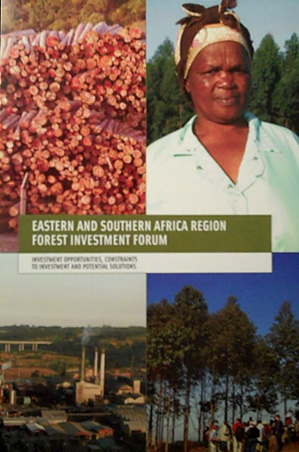
Eastern and Southern Africa Regional Forest Investment Forum
Investment Opportunities: Constraints to Investment and Potential Solutions
The Southern and East Africa Region Forest Investment Forum, held in Pietermaritzburg, South Africa, from June 13-16, 2006, identified emerging opportunities for responsible private investment in the forest sector to drive economic development, reduce poverty and conserve forest resources. The Forum discussed constraints to such investment, specifically forest sector corruption and governance failures more broadly that manifest in a lack of transparency in forest resource use, ineffective land tenure policies, and a poor investment environment.
Moreover, the Forum considered promising innovative and progressive solutions to overcome these obstacles to harnessing forests' development potential. Such solutions include:
- land tenure reform in support of community forest ownership,
- measures to increase transparency in forest resource allocation,
- market mechanisms to promote good governance such as forest certification and proof of legality,
- and the potential of payments for environmental services to deliver additional investment returns.
Corporate-community forest partnerships and small–medium scale forest based enterprises were given special consideration at the Forum as means to reduce poverty through the creation of jobs as well as markets for timber from community-owned or managed wood lots. Forum participants visited corporate-community forest operations to learn first hand how they function.
The Investment Forum provided the opportunity for representatives of governments, local communities, forest industry, conservation agencies, financial institutions and private investors to come together to not only discuss how to make such solutions work, but also to agree on specific follow up action and possibly make investment deals.
Countries from the region that were represented at the Forum included Malawi, Madagascar, Mozambique, Kenya, South Africa, Tanzania, Uganda, Zambia and Zimbabwe. The Forum was organized by the World Bank, the International Finance Corporation (IFC), and the Program on Forests (PROFOR) in partnership with South Africa's Ministry of Water Affairs and Forests (DWAF), Forestry South Africa, the International Tropical Timber Organization (ITTO), and WWF.
Two earlier Forums in this series were hosted by the World Bank, IFC, PROFOR and other partners in Washington DC in October 2003 and in Nairobi, Kenya, in April, 2005. A third International Investment Forum was hosted by ITTO, Forest Trends and CONAFOR in Cancun, Mexico, May of 2006.
The Southern and East Africa Region Forest Investment Forum, held in Pietermaritzburg, South Africa, from June 13-16, 2006, identified emerging opportunities for responsible private investment in the forest sector to drive economic development, reduce poverty and conserve forest resources. The Forum discussed constraints to such investment, specifically forest sector corruption and governance failures more broadly that manifest in a lack of transparency in forest resource use, ineffective land tenure policies, and a poor investment environment.
Moreover, the Forum considered promising innovative and progressive solutions to overcome these obstacles to harnessing forests' development potential. Such solutions include:
- Â land tenure reform in support of community forest ownership,
- measures to increase transparency in forest resource allocation,
- market mechanisms to promote good governance such as forest certification and proof of legality,
- and the potential of payments for environmental services to deliver additional investment returns.
Corporate-community forest partnerships and small–medium scale forest based enterprises were given special consideration at the Forum as means to reduce poverty through the creation of jobs as well as markets for timber from community-owned or managed wood lots. Forum participants visited corporate-community forest operations to learn first hand how they function.
The Investment Forum provided the opportunity for representatives of governments, local communities, forest industry, conservation agencies, financial institutions and private investors to come together to not only discuss how to make such solutions work, but also to agree on specific follow up action and possibly make investment deals.
Countries from the region that were represented at the Forum included Malawi, Madagascar, Mozambique, Kenya, South Africa, Tanzania, Uganda, Zambia and Zimbabwe. The Forum was organized by the World Bank, the International Finance Corporation (IFC), and the Program on Forests (PROFOR) in partnership with South Africa's Ministry of Water Affairs and Forests (DWAF), Forestry South Africa, the International Tropical Timber Organization (ITTO), and WWF.
Two earlier Forums in this series were hosted by the World Bank, IFC, PROFOR and other partners in Washington DC in October 2003 and in Nairobi, Kenya, in April, 2005. A third International Investment Forum was hosted by ITTO, Forest Trends and CONAFOR in Cancun, Mexico, May of 2006.
For stories and updates on related activities, follow us on twitter and facebook , or subscribe to our mailing list for regular updates.
Last Updated : 06-15-2024
Developing A Carbon Payment Scheme On Certified Forest Concessions
CHALLENGE
Reducing Emissions from Deforestation and Degradation (REDD) has been singled out as a promising way to cut the rate of carbon emissions, and contribute to mitigating climate change. But much of the focus has been on the first “D”. In countries with high forest cover, weak governance structures, and active concession forestry (where the challenge of measurement and enforcement will be the greatest), there may be opportunities through Sustainable Forest Management (SFM) certification, for inciting the private sector to contribute to more sustainable and less degrading concession practices that generate REDD benefits.
RESULTS
This knowledge activity explored the policy, legal and financial measures necessary to develop a carbon payment mechanism that generates incentives for concession holders to undertake practices (such as reduced-impact logging) that contribute to REDD.
It also analyzed how forest certification can be integrated into concession rules as a means of accounting for and measuring improvements to forest degradation and related carbon emissions.
For stories and updates on related activities, follow us on twitter and facebook , or subscribe to our mailing list for regular updates.
Author : Indufor
Last Updated : 06-15-2024








